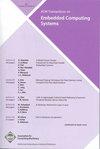DaCapo:一种内存受限嵌入式系统的设备上学习方案
IF 2.8
3区 计算机科学
Q2 COMPUTER SCIENCE, HARDWARE & ARCHITECTURE
引用次数: 0
摘要
深度神经网络(DNN)在微控制器(MCU)嵌入式系统中的应用越来越受欢迎。然而,在这种系统中,由于数据集移位问题,DNN模型经常遭受精度损失。设备上的学习解决了这个问题,它通过使用真实世界的数据在现场更新模型参数,从而将模型定位到周围环境。然而,在设备上学习期间的反向传播步骤需要将前向传递期间计算的每一层的输出存储在内存中。这在MCU设备中通常是不可行的,因为它们只配备了几个KBs的SRAM。考虑到它们的能量限制和时效性要求,使用闪存来存储每一层的输出也不现实。虽然已经提出了一些研究结果来实现严格记忆条件下的设备上学习,但它们需要修改目标模型或使用非传统的梯度计算策略。本文提出了DaCapo,一种在内存受限的嵌入式系统中实现设备上学习的反向传播方案。DaCapo只在SRAM中存储某些层(称为检查点)的输出,而丢弃其他层。丢弃的输出在反向传播期间从它们前面最近的检查点重新计算。为了最大限度地减少重新计算的发生,DaCapo在反向传播的特定阶段将检查点优化地计划存储在SRAM区域中,从而在反向传播进行时替换存储在内存中的检查点。我们在STM32F429ZI板上实现了所提出的方案,并使用五个代表性的DNN模型对其进行了评估。我们的评估表明,与AIfES(一种针对MCU设备优化的机器学习平台)相比,DaCapo将反向传播时间提高了22%,节省了28%的能耗。此外,我们提出的方法使以前MCU设备无法训练的MobileNet的训练成为可能。本文章由计算机程序翻译,如有差异,请以英文原文为准。
DaCapo: An On-Device Learning Scheme for Memory-Constrained Embedded Systems
The use of deep neural network (DNN) applications in microcontroller unit (MCU) embedded systems is getting popular. However, the DNN models in such systems frequently suffer from accuracy loss due to the dataset shift problem. On-device learning resolves this problem by updating the model parameters on-site with the real-world data, thus localizing the model to its surroundings. However, the backpropagation step during on-device learning requires the output of every layer computed during the forward pass to be stored in memory. This is usually infeasible in MCU devices as they are equipped only with a few KBs of SRAM. Given their energy limitation and the timeliness requirements, using flash memory to store the output of every layer is not practical either. Although there have been proposed a few research results to enable on-device learning under stringent memory conditions, they require the modification of the target models or the use of non-conventional gradient computation strategies. This paper proposes DaCapo, a backpropagation scheme that enables on-device learning in memory-constrained embedded systems. DaCapo stores only the output of certain layers, known as checkpoints, in SRAM, and discards the others. The discarded outputs are recomputed during backpropagation from the nearest checkpoint in front of them. In order to minimize the recomputation occurrences, DaCapo optimally plans the checkpoints to be stored in the SRAM area at a particular phase of the backpropagation and thus replaces the checkpoints stored in memory as the backpropagation progresses. We implemented the proposed scheme in an STM32F429ZI board and evaluated it with five representative DNN models. Our evaluation showed that DaCapo improved backpropagation time by up to 22% and saved energy consumption by up to 28% in comparison to AIfES, a machine learning platform optimized for MCU devices. In addition, our proposed approach enabled the training of MobileNet, which the MCU device had been previously unable to train.
求助全文
通过发布文献求助,成功后即可免费获取论文全文。
去求助
来源期刊

ACM Transactions on Embedded Computing Systems
工程技术-计算机:软件工程
CiteScore
3.70
自引率
0.00%
发文量
138
审稿时长
6 months
期刊介绍:
The design of embedded computing systems, both the software and hardware, increasingly relies on sophisticated algorithms, analytical models, and methodologies. ACM Transactions on Embedded Computing Systems (TECS) aims to present the leading work relating to the analysis, design, behavior, and experience with embedded computing systems.
 求助内容:
求助内容: 应助结果提醒方式:
应助结果提醒方式:


